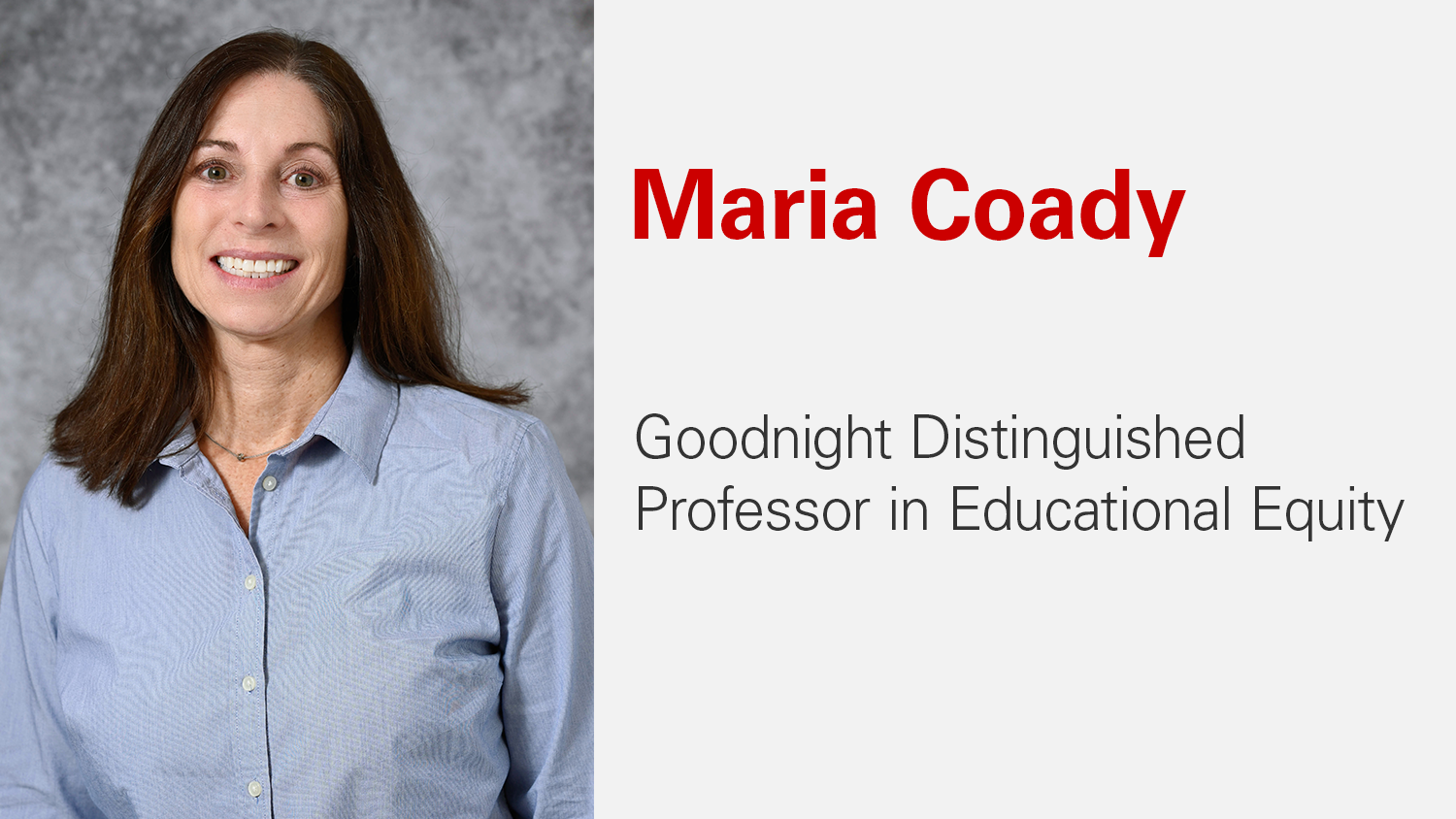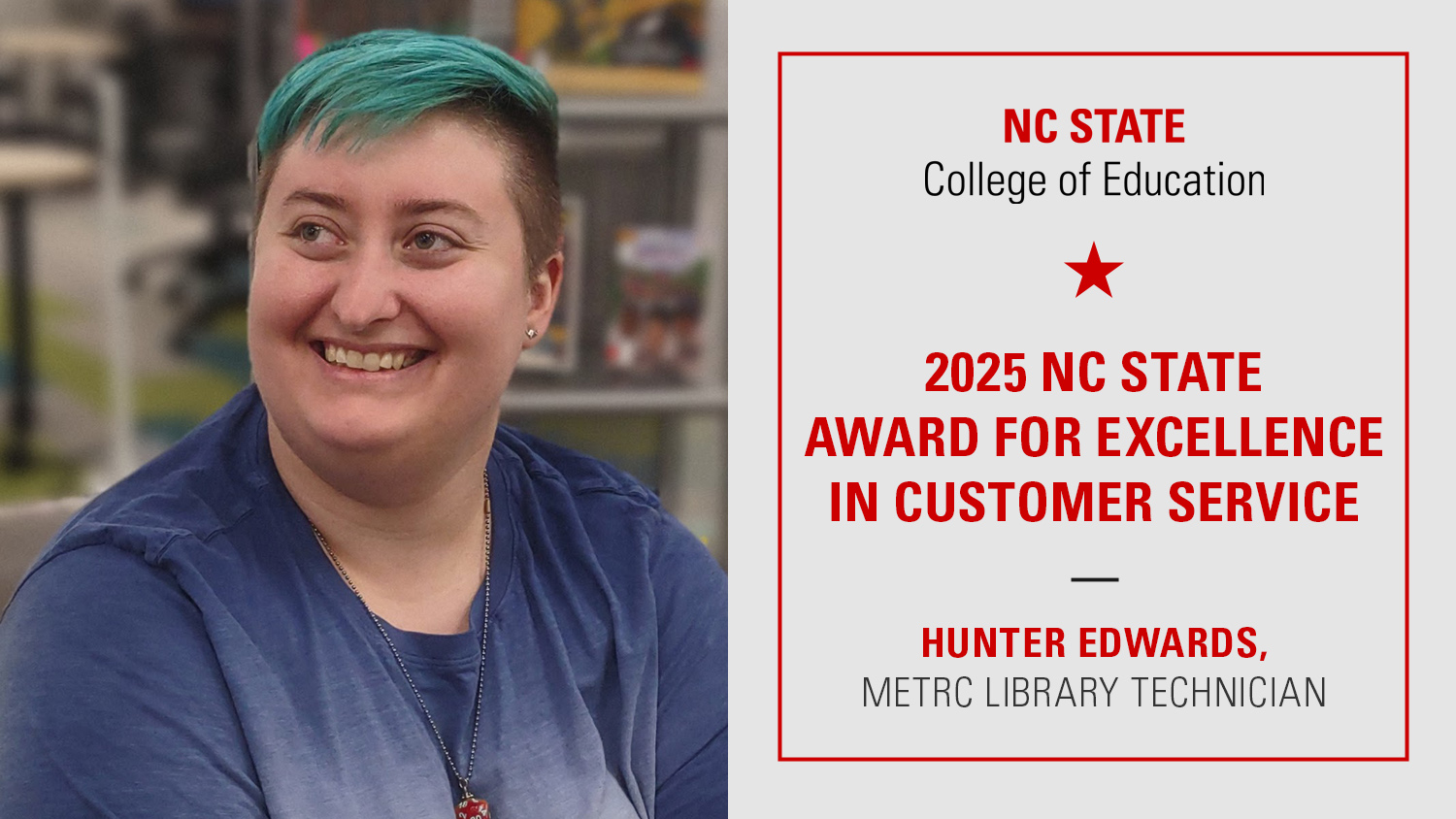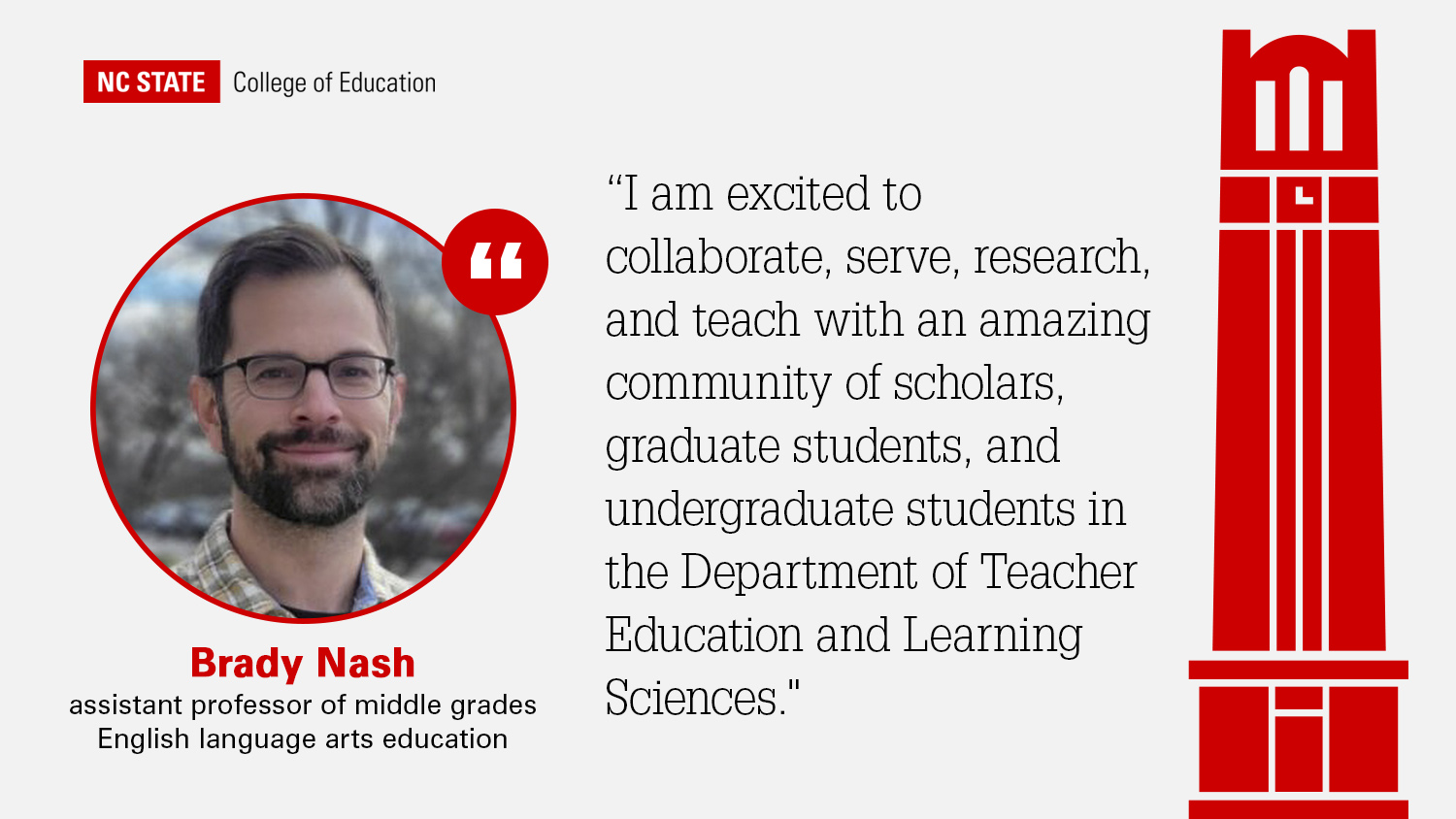Meet Inaugural College of Education Goodnight Distinguished Professor in Educational Equity Maria Coady: ‘I Really Can’t Wait to Get the Ball Rolling and Get Out There and Meet People in Communities and Spaces’

Maria Coady joined the NC State College as the inaugural Goodnight Distinguished Professor in Educational Equity on Aug. 16, 2022.
Coady’s research focuses on English language and multilingual learners in rural settings with a particular focus on students’ literacy and language development, educational practices for rural multilingual students and ways educators and schools can best engage multilingual learners and their families.
In the following interview, Coady discusses why she chose a career in education, how she developed a passion for multilingual learning, why she’s excited to join the College of Education and what equity means to her.
This Q&A has been edited for length and clarity.
Why did you choose a career in education?
I’ve been an educator for as long as I can remember, but I think my earliest experiences in language education really began when I was in high school. My personal family was from a multilingual background, an immigrant background, and I remember growing up hearing different languages around me in our small speech community in Massachusetts.
Then as I got older and I was in high school, I just had a real love for languages and for working with immigrant families and communities. I remember from a very young age, interpreting for families where they were in a store and couldn’t understand things and I just enjoyed that very much. It became more of a passion of mine as I got older and I began to teach languages when I was in college and later on when I worked in the Massachusetts Migrant Education Program and in public schools.
Share with us your experiences of growing up in a multilingual family.
We grew up in a small speech community north of Boston, Massachusetts, that was Italian speaking. In my family, my great aunts and uncles were immigrants. Extended family was a very important part of our family culture and many of my family members didn’t speak much English at all. My grandmother did and my grandfather did, and so they were some of the newer generation that, like many immigrant families, wanted their children to learn English.
My story is a really similar story to many Americans who come from immigrant backgrounds, whose family come to the United States and who speak a language, but it’s sort of lost to the 2.5 generation. I was one of those young speakers that came back and wanted to learn language as a result of having lost it in my family.
In two and a half generations, the language is often lost to young speakers. We see this in the census data when we look and trace language patterns and language losses across the country. Really, it’s my mission for that not to happen to many of our immigrant children and families today. We know that there is such a great cognitive and social benefit to knowing multiple languages. I don’t want them to just retain the home or heritage language, I want them to learn even more. So, that’s a mission that’s really undergirded a lot of the work that I’ve done in the last 20 years.
Why are you excited to bring your research on rural multilingual education to North Carolina?
I am so excited about joining the faculty at NC State. I really feel like this is just a wonderful place for my research.
My research generally focuses on multilingual learners and the educators who work with them and I sub specialize in the area of rurality. So, my research in the past 20 years has shown the way that critical place matters in both educator preparation and how that influences and shapes the work of educators.
This is sort of a very narrow area of research that taps into a lot of the demographics and a lot of the very exciting changes that have taken place in North Carolina in the past eight to 10 years, where there has been a tremendous growth in multilingual learners, in particular in rural communities. North Carolina has 100 counties and 80 of them are designated as rural so, to me, that’s wonderful.
NC State also has extensions in every single county in the state. I really can’t wait to get the ball rolling and get out there and meet people in communities and spaces. There has been 160% growth in multilingual students across the state of North Carolina within the last decade. We have a lot of work to do and I think that we can make a tremendous, significant difference. I’m really ready to be on the ground and work with people and meet people in the state.
What first interested you in focusing your research on rural populations?
I really have a heart for small towns and rural communities. At the personal level, I find them peaceful, interesting, and exciting. I’m always fascinated by people’s relationship to the land and the space around them and how that affects the work that we do and the way communities come together.
There are interesting narratives surrounding what rurality means and who inhabits rural places. I think we’ve struggled a bit and suffered nationally from stereotypes about who inhabits rural spaces and ways that those communities function. I find it interesting that communities function in patterned ways and in ways where people in rural and underserved communities learn to utilize resources in ways that are creative, that tap into their strengths and that demonstrate connections between resources, people and places.
I’m also very curious about why immigrants come to the places that they do. Many times it’s for work reasons, but I’ve also seen immigrants and families come into places that don’t seem as logical. I’m very curious as to how they get there and why. The second thing that interests me is the way that they are able to navigate the community. Their resilience and the way that they are able to be in a place where maybe linguistic resources are not available to them, to me, demonstrates the strength of people. It comes across in their language, it comes across in their familial relationships, and it comes across in how they network and build a broader social network.
These are kind of strengths that often are left unnoticed in communities, especially rural communities. They’re sort of invisible, so I like to look at those patterns and look at those places and try to identify what the resources are in those places. When we really look, I think we can clearly see how these are strength-based places.
What do you see as some of the biggest opportunities in terms of drawing on the strengths of rural communities in North Carolina?
One of the very first things that I’m going to do when I set up my office is to print out a map of the state that’s massive, and I’m going to start really looking at where our immigrant families and students are located. I’m also very curious as to where our dual language and bilingual programs are located geospatially and geographically in the state.
I think when we build relationships in these communities, we’ll find that there are often linguistic resources there, but they remain invisible. Rural schools have to leverage their human resources. There might, for instance, be a high school Spanish teacher who might be a native Spanish speaker from a particular country and knows a lot about culture and language. But, that as a linguistic resource may not be tapped into to facilitate, for instance, high school students obtaining a seal of biliteracy on their diploma to demonstrate that they can read and write in more than one language.
Leveraging linguistic resources means really meeting people, knowing who they are and what they bring and how they contribute to the community and then finding ways to creatively address some structural inequities. My goal is to come out and really understand the way schools are functioning now in rural communities and the resources– linguistic, human and other resources– that exist there and start to map that out for the state.
What are some of the greatest needs now related to preparing pre-service educators to teach multilingual students?
We need more teachers and it’s a hard job. I want every educator to feel confident in the work that they do and confident in their preparation so that when they have a new, multilingual learner walk into their classroom, they know exactly what to do, they know ways to greet the child and the family and the resources that they can use to reach out to that family. We’re struggling in education in creating spaces to engage multilingual families.
Ideally, a pre-service teacher has the opportunity to go and understand how rural communities, suburban communities and urban communities function. There will be some educators that really love working in rural places like I do and others that really love working in urban communities. We need everybody’s hard work and commitment to improve education, but really to serve multilingual learners and work with their families.
I want every one of them to feel confident in what they have to do. Some of the research that I’ve done shows that one of the areas pre-service teachers feel least confident in is engaging families. There’s lots we can do for them to be effective and know how to address that. So, that’s one thing that I’d like to see us do well.
How do you believe your extensive international work has helped to shape your approach to research and teaching?
I really enjoy doing international work. Every day going to work, I learn something new but it’s really evident going into a new country where education might be nationally centralized or where the national curriculum likely includes religious education, which is something we don’t talk about too much in public schools in the United States. It helps me to understand different paradigms, different ways that countries, cultures, and groups of communities participate in children’s education and the way they receive and host immigrant families in communities.
The world is very diverse and we have a lot that we can learn from other countries. Cultural ways of thinking about education and the role of families, in particular, is very interesting to me and I learn about that by going to other places.
What was your experience like getting to serve as a Fulbright Scholar multiple times?
I was a Fulbright Scholar in three countries. I was a Fullbright Scholar in Ukraine in 2013 and I was a Fullbright Scholar in Poland this past year. One of the reasons I was selected by Fulbright to work in Poland was because of the work in Ukraine. Ukrainians are the largest immigrant group to Poland; they had been before the war and they clearly are now after the war. But Ukrainians are not part of the European Union, so when they arrived in Poland, they were immigrants. What happened overnight, with the war in February, was that Ukranians went from being immigrants to refugees and that really has changed the entire narrative now of the way schools are outreaching to Ukrainian women and children that are now in Poland alone and thinking about educating them.
I also did a Fulbright assignment in South Africa and I was working with a very good colleague of mine named Leketi Makalela in Johannesburg, working with South African multilingual children. One of the sites that we worked at and visited was up at the Mozambique border, at a very rural, very under-resourced school. I just have the fondest memories of these children performing, because the way that they were able to display their literacy learning was through the use of poetry and performance. The intellectual, creative backgrounds of these children was just fascinating.
I would encourage any scholar, any educator, to work with Fulbright if possible. Fulbright is an amazing organization to work with. To be selected is already a great honor, but when we get selected to be Fulbright Scholar, they allow us to really do the work that we are there to do . It’s wonderful and they’re very supportive.
What are you most looking forward to in working with College of Education students?
I am so excited to work with students at NC State. They have some fabulous programs already there and students working in the area of educational equity, so I am excited to learn about the students themselves, their backgrounds and what they bring, and what they are seeking in terms of educational equity.
I would love to work with some of these graduate students that have worked, for instance, in dual language programs who can help me unpack the landscape of North Carolina and see what that looks like in rural North Carolina. One of the things I’m looking forward to is the way that we can work together and build relationships together to serve people in the state of North Carolina.
One of the things that I do in teaching, particularly with the graduate students but also with the undergraduates, is to make sure we have a lot of agency together. For instance, with my Ph.D. students, I have them sign up and we co-plan and co-teach a class on a selected topic together. It’s fascinating to me how much they know. It’s a good experience for them working in higher education because they will be the next generation of faculty members. I learn a lot about them personally in those moments and I appreciate them and all that they’ve been doing.
What does equity in education look like to you?
Equity is a big thing that we often don’t unpack and I think we have to very carefully unpack pieces of equity. Someone once told me, and I do think this, that equity right now for us, in education, is something that we have to imagine and go toward, it’s not something we have in our lived experience. WIth that in mind, the unpacking is very careful and cautious and tender in a way. We have to think about equity itself in unique and diverse ways.
Issues of race are very much at the social forefront right now and these intersect so much with language issues, both in terms of standard English or multilingualism. Educational equity is a big mission, but if we can unravel it piece by piece, then we can really put a lens on it, knowing that it’s much bigger than what we might be able to do in one go, even together.
The other thing I find interesting about equity is how it’s changed over the years. In 2019, I wrote a book called the Coral Way Bilingual Program. It’s about the first real dual language or bilingual education program created in the U.S. in Miami-Dade Public Schools in the 1960s, following the Cuban Refugee Crisis. The way people talked about equity back then is definitely not the way people talk about it today. I think we have a more sophisticated and nuanced and granular view of equity. I think we have a clearer sense of direction and a lot more galvanizing of forces around equity issues. I think we have come a long way in 60 years. It is still something we can only imagine for our children, grandchildren or further out– that these are spaces that we know can occur– but I think it’s changed a lot.
I see equity as a dynamic space. We don’t know exactly what it looks like but I think we all know what it feels like when we’re in a humanizing, loving, equitable educational space. I can feel it when I walk into a classroom and it is an equity space and I see educators and children affirming each other in ways that are humanizing. Whether or not we can do it on a bigger scale, we’re working on that.
- Categories:


